What is the metaverse?
The metaverse represents a collective virtual shared space, created by the convergence of virtually enhanced physical reality and persistent virtual spaces, including the sum of all virtual worlds, augmented reality, and the internet.
Envisioned as the next iteration of connectivity, the metaverse promises a future where digital experiences become as integral to everyday life as those in the physical world.
Far from being a mere buzzword, this concept extends beyond gaming and social media to include realms like commerce, education, and remote work.
In the metaverse, users navigate through immersive experiences typically facilitated by virtual reality (VR) or augmented reality (AR) technology.
This digital universe allows for interactions and activities that mirror real life, with the addition of possibilities limited only by imagination.
As these technologies evolve, the line between physical and virtual realities continues to blur, offering more seamless transitions and integrations in day-to-day life.
The metaverse also implies a degree of interoperability, suggesting that a user might move virtual items like clothing or cars from one platform to another, much like how the internet enabled the flow of information between different web spaces.
Initially popularized by the novel "Snow Crash", the term metaverse has since been adopted by a wide range of projects aiming to create their own versions of this digital ecosystem.
From legacy online environments like Second Life to the more recent ventures by tech giants, the race to define and build the metaverse is very much on.
As augmented and virtual reality technologies continue to advance, the prospect of an interconnected virtual world seems not only possible but inevitable.
Historical Context and Evolution
The metaverse has transitioned from a science fiction concept to an emergent digital ecosystem, influenced by advancements in virtual worlds, gaming, and social media.
From Science Fiction to Reality
The term "metaverse" was coined in Neal Stephenson's 1992 novel, Snow Crash, where it referred to a virtual reality-based successor to the internet. This fictional concept has gradually become a tangible goal for technologists aiming to create an all-encompassing, interactive virtual space.
The Growth of Virtual Worlds
Virtual worlds gained popularity with platforms like Second Life, launched in 2003. It allowed users to create avatars and engage in various activities within a user-generated world, laying foundational ideas for today's metaverse.
This early example provided a canvas for social interaction and economic transactions in a shared digital space.
Influence of Games and Social Media
The gaming industry has significantly contributed to the metaverse's development with platforms like Minecraft, Roblox, and Fortnite offering immersive, creative, and social experiences.
These games have established large communities and are seen as precursors to the metaverse due to their expansive and interactive environments.
Social media has further accelerated the metaverse by integrating social interactions with virtual experiences, creating hybrid spaces for users to interact beyond traditional platforms.
Technological Foundations
The Metaverse rests on advanced technological underpinnings that define its capability and reach. It fuses various elements including computation capacities, immersive 3D environments, and interactive systems facilitated by AI and machine learning.
Key Technologies Behind the Metaverse
Several technologies converge to create the infrastructure of the Metaverse.
Virtual Reality (VR) and Augmented Reality (AR) stand at the forefront, providing the immersive and interactive experiences users expect.
Specifically, VR engulfs users in a 3D virtual space, while AR overlays digital content onto the real world.
The Metaverse leverages high-performance computing, with companies such as NVIDIA advancing graphics processing units (GPUs) critical for rendering complex 3D environments.
Hardware and Devices for Accessibility
To access the Metaverse, specific hardware and devices are essential.
VR headsets, notably those from Oculus, are vital for a fully immersive experience.
These headsets contain advanced sensors and optics to track movements and display the virtual world.
On the other hand, Qualcomm is instrumental in developing chipsets that power a range of devices from smartphones to standalone VR equipment.
Role of AI and Machine Learning
AI and machine learning algorithms are the backbone of the Metaverse, allowing for intelligent and responsive environments.
They support features such as natural language processing, object recognition, and predictive interactions, enhancing the user experience.
As the Metaverse evolves, AI's role will expand, managing vast amounts of data to create more personalized and engaging virtual spaces.
Major Platforms and Players
Within the rapidly evolving realm of digital spaces, specific entities have solidified their presence as either early adopters or significant contributors to the concept of the metaverse.
Early Pioneers and Emerging Giants
Meta, formerly known as Facebook, was one of the first major companies to invest heavily in the metaverse, signaling a strategic pivot by rebranding and dedicating resources to develop its virtual space.
Similarly, Roblox has stood out as a platform where users don't just consume content but actively create and participate in digital experiences, setting a precedent for user-generated content in the metaverse.
Innovators such as Nvidia have contributed to the underlying technology, with advancements in graphics processing that have bolstered the visualization and feasibility of metaverse environments.
Their commitment emphasizes the technical backbone necessary for such expansive virtual worlds.
Corporate Presence in the Metaverse
Microsoft has made strategic moves by integrating their existing services like Microsoft Teams with mixed reality applications, showcasing a bet on enterprise utility in the metaverse.
The company's acquisition of assets like Minecraft serves as a bridge between leisure and professional digital realms.
The likes of Google have explored the metaverse indirectly, focusing on complementary technologies such as augmented reality through platforms like Google ARCore, which enables immersive experiences overlayed on the physical world.
Metaverse Economy
The Metaverse Economy encompasses a wide array of economic activities related to virtual goods and services, cryptocurrencies, and emerging business opportunities that mirror real-world commerce and investment within digital spaces.
Virtual Goods and Services
The Metaverse has unlocked a market for virtual goods and services that goes beyond mere digital assets.
Users can purchase content such as customizable avatars, digital apparel, and exclusive in-game items.
Brands have started to open virtual shops where they sell products that can be used within the Metaverse or tied to physical products.
Additionally, services like virtual concerts and events draw in large audiences, demonstrating another revenue stream.
Digital Apparel: Items for avatars, such as clothing or accessories.
Event Tickets: Access passes to virtual concerts or exclusive events.
Cryptocurrencies and NFTs
Transactions within the Metaverse often utilize cryptocurrency, providing a secure means of exchange across various platforms.
Non-fungible tokens (NFTs) represent ownership of unique digital items and have seen a marked rise in popularity, serving as a cornerstone of the Metaverse's digital economy.
Cryptocurrency: Used for transactions and as an investment vehicle.
NFTs: Certify ownership of digital assets.
Business Opportunities and Investments
Investment in the Metaverse has burgeoned as stakeholders identify its potential to expand further.
No longer just a niche for tech enthusiasts, the Metaverse economy is rapidly attracting venture capitals and existing companies looking to position themselves within these new digital worlds.
They see investment opportunities not only in direct platform development but also in the infrastructure and applications that will support the Metaverse ecosystem.
Social and Cultural Impact
The Metaverse is weaving new patterns in the fabric of social interactions and culture. It is reshaping the way individuals connect, learn, and entertain themselves.
Social Interaction and Community
In the Metaverse, social connection is revolutionized as individuals meet and interact through avatars.
Community spaces in the Metaverse allow for gatherings from virtual concerts to casual meetups, transcending geographical boundaries. According to Forbes, this enhanced online interaction is a more immersive iteration of the internet.
Modes of meeting:
Virtual reality (VR) gatherings
Digital town halls
Avatar-based networking events
Entertainment and Media
The entertainment sector of the Metaverse offers an array of experiences, from films to virtual concerts.
For example, spectators can attend performances by their favorite artists as if they were there in person.
These immersive experiences are reshaping the landscape of media consumption. The World Economic Forum discusses the adoption of these new forms of entertainment and its implications.
Examples of media transformations:
Interactive movie-watching spaces
Live-streamed virtual reality concerts
Education and Training
The Metaverse's influence on education is significant, enabling immersive learning environments and interactive training simulations.
Students can participate in virtual classrooms and engage with educational content in ways that were previously impossible.
Healthcare training in the Metaverse, for example, allows medical students to practice procedures in a risk-free environment.
This shift is detailed by educational institutions like NYU, elucidating transformative changes in learning modalities.
Educational deployments:
Virtual field trips
Simulated surgical training stations
Challenges and Controversies
The rapid expansion of the metaverse brings to light significant concerns that span privacy, security, and ethical governance.
These controversies center on the complexity of safeguarding user data and controlling the spread of misinformation within these virtual environments, where regulations have yet to catch up with the technology’s advancement.
Privacy and Security Issues
In the metaverse, privacy and security present substantial challenges, as personalized experiences often rely upon the collection of sensitive data.
The inherent risk of data breaches and cyber attacks amplifies in environments such as Forbes discusses the metaverse, where interactions and transactions take digital forms.
Virtual spaces require fortified security measures, not only to protect against unauthorized data access but also to ensure users' safety within these realms.
Concerns:
Potential for data exploitation
Risk of identity theft
Inadequate user consent mechanisms
Misinformation and Content Moderation
Misinformation within the metaverse can swiftly propagate due to its expansive and immersive nature.
The platforms' ability to handle and moderate content effectively is a growing concern.
As TechTarget explains, creating lifelike experiences raises the stakes for content verification and fact-checking, emphasizing the need for robust content moderation systems to curtail the spread of false information and prevent various forms of abuse.
Challenges:
Establishing reliable fact-checking methods
Developing scalable moderation tools
Balancing free expression and content control
Ethical Considerations and Governance
The dizzying potential of the metaverse cannot obscure the pressing need for ethical considerations and governance.
As stakeholders participate in these digital domains, questions arise about equitable access and the fair use of emerging technologies like blockchain.
Entities such as Brookings Institution highlight the metachallenges that need to be addressed, including setting transparent policies and regulations that cover all aspects of metaverse participation and protect users from exploitation.
Governance Issues:
Crafting comprehensive usage policies
Ensuring equitable access across varied demographics
Regulating economic activities within virtual economies
Future Prospects
The metaverse future is anchored on technological progression, ushering in new levels of digital interaction and expanding virtual economies.
These prospects are not only reshaping user experiences but also the way people live and work in virtual spaces.
Advancements in Immersive Technologies
Immersive technologies such as virtual reality (VR) and augmented reality (AR) are central to the evolution of the metaverse.
As spatial computing becomes more sophisticated, it will allow for more intricate and realistic simulations.
Industries are investing in cloud computing to ensure these virtual worlds can be accessed smoothly, enhancing user immersion.
The integration of extended reality technologies is a critical driver of metaverse experiences, making them more seamless and interactive.
The Concept of a Multiverse
The metaverse concept may evolve into a multiverse, where numerous interconnected virtual worlds exist.
This level of interoperability between platforms gives rise to a thriving ecosystem where users can navigate between worlds without friction.
The backbone of this integration is Web3, which enables a decentralized internet and supports digital asset ownership across various platforms.
Organizations are striving to create a unified metaverse that extends beyond proprietary systems and devices.
Long-Term Vision and Predictions
Long-term predictions indicate the metaverse could transform how individuals interact with the internet altogether.
The convergence of the mobile internet and virtual environments hints at a future where our digital lives may be as significant as our physical ones.
Strategists forecast that storytelling, business, and social connections in the metaverse will emerge as new norms, supported by consistent advances in technology and user-centric features that boldly shape the trajectory of the metaverse.





